Interdecadal Change in the Covariability of the Tibetan Plateau and Indian Summer Precipitation and Associated Circulation Anomalies
Abstract
1. Introduction
2. Materials and Methods
3. Results
3.1. Interdecadal Change in Covariability of TP and Indian Summer Precipitation
3.2. Reasons for Covariability and Non-Covariability
3.2.1. Dominant Circulation Anomalies for Covariability during 2005–2019
3.2.2. Reason for Non-Covariability during 1981–2004
4. Discussion
5. Conclusions
Author Contributions
Funding
Institutional Review Board Statement
Informed Consent Statement
Data Availability Statement
Conflicts of Interest
References
- Qiu, J. The third pole. Nature 2008, 454, 393–396. [Google Scholar] [CrossRef]
- Lu, C.; Xie, G.; Cheng, S.; Li, S. The Tibetan Plateau as Water Tower. J. Mt. Sci. 2004, 22, 428–432. (In Chinese) [Google Scholar]
- Davis, M.E.; Thompson, L.G.; Yao, T.D.; Wang, N.L. Forcing of the Asian monsoon on the Tibetan Plateau: Evidence from high-resolution ice core and tropical coral records. J. Geophys. Res. Atmos. 2005, 110, D04101. [Google Scholar] [CrossRef]
- Immerzeel, W.W.; van Beek, L.P.H.; Bierkens, M.F.P. Climate Change Will Affect the Asian Water Towers. Science 2010, 328, 1382–1385. [Google Scholar] [CrossRef] [PubMed]
- Feng, L.; Zhou, T. Water vapor transport for summer precipitation over the Tibetan Plateau: Multidata set analysis. J. Geophys. Res. Atmos. 2012, 117, D20114. [Google Scholar] [CrossRef]
- Pang, G.; Wang, X.; Yang, M. Using the NDVI to identify variations in, and responses of, vegetation to climate change on the Tibetan Plateau from 1982 to 2012. Quatern. Int. 2017, 444, 87–96. [Google Scholar] [CrossRef]
- Zhang, C.; Tang, Q.; Chen, D.; van der Ent, R.J.; Liu, X.; Li, W.; Haile, G.G. Moisture Source Changes Contributed to Different Precipitation Changes over the Northern and Southern Tibetan Plateau. J. Hydrometeorol. 2019, 20, 217–229. [Google Scholar] [CrossRef]
- Wang, T.; Zhao, Y. Relationships between Thermal Anomalies over the Qinghai-Xizang Plateau and Tropical Indian Ocean in May with Summer Rainfall in Xinjiang. Plateau Meteor. 2021, 40, 1–14. (In Chinese) [Google Scholar]
- Wang, T.; Zhao, Y. Influences of summer thermal anomalies over the Tibetan Plateau and the tropical Indian Ocean on summer rainfall in the Tarim Basin. Clim. Environ. Res. 2021, 26, 275–288. (In Chinese) [Google Scholar]
- Duan, A.M.; Wu, G.X. Role of the Tibetan Plateau thermal forcing in the summer climate patterns over subtropical Asia. Clim. Dyn. 2005, 24, 793–807. [Google Scholar] [CrossRef]
- Duan, A.; Wang, M.; Lei, Y.; Cui, Y. Trends in Summer Rainfall over China Associated with the Tibetan Plateau Sensible Heat Source during 1980–2008. J. Clim. 2013, 26, 261–275. [Google Scholar] [CrossRef]
- Liu, G.; Zhao, P.; Chen, J.M.; Yang, S. Preceding Factors of Summer Asian-Pacific Oscillation and the Physical Mechanism for Their Potential Influences. J. Clim. 2015, 28, 2531–2543. [Google Scholar] [CrossRef]
- Liu, G.; Zhao, P.; Chen, J.M. Possible Effect of the Thermal Condition of the Tibetan Plateau on the Interannual Variability of the Summer Asian-Pacific Oscillation. J. Clim. 2017, 30, 9965–9977. [Google Scholar] [CrossRef]
- Wu, G.; Zhuo, H.; Wang, Z.; Liu, Y. Two types of summertime heating over the Asian large-scale orography and excitation of potential-vorticity forcing I. Over Tibetan Plateau. Sci. China Earth Sci. 2016, 59, 1996–2008. [Google Scholar] [CrossRef]
- Lu, M.; Yang, S.; Li, Z.; He, B.; He, S.; Wang, Z. Possible effect of the Tibetan Plateau on the “upstream” climate over West Asia, North Africa, South Europe and the North Atlantic. Clim. Dyn. 2018, 51, 1485–1498. [Google Scholar] [CrossRef]
- Chen, J.M.; Yue, X.Y.; Liu, G.; Nan, S.L. Relationship between the thermal condition of the Tibetan Plateau and precipitation over the region from eastern Ukraine to North Caucasus during summer. Theor. Appl. Climatol. 2020, 142, 1379–1395. [Google Scholar] [CrossRef]
- Nan, S.; Zhao, P.; Chen, J. Variability of summertime Tibetan tropospheric temperature and associated precipitation anomalies over the central-eastern Sahel. Clim. Dyn. 2019, 52, 1819–1835. [Google Scholar] [CrossRef]
- Nan, S.; Zhao, P.; Chen, J.; Liu, G. Links between the thermal condition of the Tibetan Plateau in summer and atmospheric circulation and climate anomalies over the Eurasian continent. Atmos. Res. 2021, 247, 105212. [Google Scholar] [CrossRef]
- Liu, H.; Duan, K. Effects of North Atlantic Oscillation on Summer Precipitation over the Tibetan Plateau. J. Glaciol. Geocryol. 2012, 34, 311–318. [Google Scholar]
- Zhou, S.; Wu, P.; Wang, C.; Han, J. Spatial distribution of atmospheric water vapor and its relationship with precipitation in summer over the Tibetan Plateau. J. Geogr. Sci. 2012, 22, 795–809. [Google Scholar] [CrossRef]
- Liu, H.; Duan, K.; Li, M.; Shi, P.; Yang, J.; Zhang, X.; Sun, J. Impact of the North Atlantic Oscillation on the Dipole Oscillation of summer precipitation over the central and eastern Tibetan Plateau. Int. J. Climatol. 2015, 35, 4539–4546. [Google Scholar] [CrossRef]
- Yao, T.; Bolch, T.; Chen, D.; Gao, J.; Immerzeel, W.; Piao, S.; Su, F.; Thompson, L.; Wada, Y.; Wang, L.; et al. The imbalance of the Asian water tower. Nat. Rev. Earth Environ. 2022, 3, 618–632. [Google Scholar] [CrossRef]
- Ma, J.; Ren, H.-L.; Cai, M.; Huang, J. Seasonally Evolving Trends Explain the North-South Dipole Pattern Observed in Tibetan Plateau Precipitation. Geophys. Res. Lett. 2023, 50, e2023GL104891. [Google Scholar] [CrossRef]
- Ding, J.; Cuo, L.; Zhang, Y.; Zhang, C.; Liang, L.; Liu, Z. Annual and Seasonal Precipitation and Their Extremes over the Tibetan Plateau and Its Surroundings in 1963–2015. Atmosphere 2021, 12, 620. [Google Scholar] [CrossRef]
- Yu, R.-C.; Li, J.; Zhang, M.-M.; Li, N.N.; Zhao, Y. South drying and north wetting over the Tibetan Plateau modulated by a zonal temperature dipole across timescales. Adv. Clim. Chang. Res. 2023, 14, 276–285. [Google Scholar] [CrossRef]
- Hu, S.; Zhou, T.; Wu, B. Impact of Developing ENSO on Tibetan Plateau Summer Rainfall. J. Clim. 2021, 34, 3385–3400. [Google Scholar] [CrossRef]
- He, K.; Liu, G.; Wu, R.; Nan, S.; Wang, S.; Zhou, C.; Qi, D.; Mao, X.; Wang, H.; Wei, X. Oceanic and land relay effects linking spring tropical Indian Ocean sea surface temperature and summer Tibetan Plateau precipitation. Atmos. Res. 2022, 266, 105953. [Google Scholar] [CrossRef]
- Li, Z.; Xiao, Z.; Ling, J. Impact of extremely warm Tibetan Plateau in spring on the rare rainfall anomaly pattern in the regions west and east to Plateau in late summer 2022. Atmos. Res. 2023, 290, 106797. [Google Scholar] [CrossRef]
- Duan, A.; Wu, G. Weakening trend in the atmospheric heat source over the Tibetan plateau during recent decades. Part I: Observations. J. Clim. 2008, 21, 3149–3164. [Google Scholar] [CrossRef]
- Jiang, X.; Li, Y.; Yang, S.; Yang, K.; Chen, J. Interannual Variation of Summer Atmospheric Heat Source over the Tibetan Plateau and the Role of Convection around the Western Maritime Continent. J. Clim. 2016, 29, 121–138. [Google Scholar] [CrossRef]
- Wu, G.; Liu, Y.; He, B.; Bao, Q.; Duan, A.; Jin, F.-F. Thermal Controls on the Asian Summer Monsoon. Sci. Rep. 2012, 2, 404. [Google Scholar] [CrossRef]
- Yao, T.; Masson-Delmotte, V.; Gao, J.; Yu, W.; Yang, X.; Risi, C.; Sturm, C.; Werner, M.; Zhao, H.; He, Y.; et al. A review of climatic controls on δ18O in precipitation over the Tibetan Plateau: Observations and simulations. Rev. Geophys. 2013, 51, 525–548. [Google Scholar] [CrossRef]
- Zhou, L.; Zou, H.; Ma, S.; Li, F.; Zhu, J.; Li, P.; Zhang, Y. The observed impacts of South Asian summer monsoon on the local atmosphere and the near-surface turbulent heat exchange over the Southeast Tibet. J. Geophys. Res. 2015, 120, 11509–11518. [Google Scholar] [CrossRef]
- Jiang, X.; Ting, M. A Dipole Pattern of Summertime Rainfall across the Indian Subcontinent and the Tibetan Plateau. J. Clim. 2017, 30, 9607–9620. [Google Scholar] [CrossRef]
- Ren, Q.; Zhou, C.; He, J.; Cen, S.; Deng, M. Impact of Preceding Indian Ocean Sea Surface Temperature Anomaly on Water Vapor Content over the Tibetan Plateau Moist Pool in Summer and Its Possible Reason. Chin. J. Atmos. Sci. 2017, 41, 648–658. (In Chinese) [Google Scholar]
- Liu, M.; Ren, H.-L.; Wang, R.; Ma, J.; Mao, X. Distinct Impacts of Two Types of Developing El Niño-Southern Oscillations on Tibetan Plateau Summer Precipitation. Remote Sens. 2023, 15, 4030. [Google Scholar] [CrossRef]
- Dong, W.; Lin, Y.; Wright, J.S.; Ming, Y.; Xie, Y.; Wang, B.; Luo, Y.; Huang, W.; Huang, J.; Wang, L.; et al. Summer rainfall over the southwestern Tibetan Plateau controlled by deep convection over the Indian subcontinent. Nat. Commun. 2016, 7, 10925. [Google Scholar] [CrossRef]
- National Geophysical Data Center. 2-minute Gridded Global Relief Data (ETOPO2) v2. National Geophysical Data Center, NOAA. 2006. Available online: https://www.ngdc.noaa.gov/mgg/global/relief/ETOPO2/ETOPO2v2-2006/ (accessed on 18 August 2022).
- Schneider, U.; Becker, A.; Finger, P.; Rustemeier, E.; Ziese, M. GPCC Full Data Monthly Product Version 2020 at 1.0°: Monthly Land-Surface Precipitation from Rain-Gauges Built on GTS-Based and Historical Data. 2020. Available online: https://opendata.dwd.de/climate_environment/GPCC/html/fulldata-monthly_v2020_doi_download.html (accessed on 24 May 2023).
- Adler, R.F.; Huffman, G.J.; Chang, A.; Ferraro, R.; Xie, P.P.; Janowiak, J.; Rudolf, B.; Schneider, U.; Curtis, S.; Bolvin, D.; et al. The version-2 global precipitation climatology project (GPCP) monthly precipitation analysis (1979-present). J. Hydrometeorol. 2003, 4, 1147–1167. [Google Scholar] [CrossRef]
- Harris, I.; Osborn, T.J.; Jones, P.; Lister, D. Version 4 of the CRU TS monthly high-resolution gridded multivariate climate dataset. Sci. Data 2020, 7, 109. [Google Scholar] [CrossRef]
- Hersbach, H.; Bell, B.; Berrisford, P.; Hirahara, S.; Horanyi, A.; Munoz-Sabater, J.; Nicolas, J.; Peubey, C.; Radu, R.; Schepers, D.; et al. The ERA5 global reanalysis. Quart. J. R. Meteorol. Soc. 2020, 146, 1999–2049. [Google Scholar] [CrossRef]
- Huang, B.; Thorne, P.W.; Banzon, V.F.; Boyer, T.; Chepurin, G.; Lawrimore, J.H.; Menne, M.J.; Smith, T.M.; Vose, R.S.; Zhang, H.-M. Extended Reconstructed Sea Surface Temperature, Version 5 (ERSSTv5): Upgrades, Validations, and Intercomparisons. J. Clim. 2017, 30, 8179–8205. [Google Scholar] [CrossRef]
- Hu, M.; Gong, D.; Wang, L.; Zhou, T.; Zhang, Z. Possible influence of January-March Arctic Oscillation on the convection of tropical North Pacific and North Atlantic. Acta Meteorol. Sin. 2012, 70, 479–491. (In Chinese) [Google Scholar]
- Yue, X.; Liu, G.; Chen, J.; Zhou, C. Synergistic regulation of the interdecadal variability in summer precipitation over the Tianshan mountains by sea surface temperature anomalies in the high-latitude Northwest Atlantic Ocean and the Mediterranean Sea. Atmos. Res. 2020, 233, 104717. [Google Scholar] [CrossRef]
- He, K.; Liu, G.; Wu, R.; Nan, S.; Li, J.; Yue, X.; Wang, H.; Wei, X.; Li, R. Effect of preceding soil moisture-snow cover anomalies around Turan Plain on June precipitation over the southern Yangtze River valley. Atmos. Res. 2021, 264, 105853. [Google Scholar] [CrossRef]
- Wang, H.; Liu, G.; Wang, S.; He, K. Precursory Signals (SST and Soil Moisture) of Summer Surface Temperature Anomalies over the Tibetan Plateau. Atmosphere 2021, 12, 146. [Google Scholar] [CrossRef]
- Chen, X.; You, Q. Effect of Indian Ocean SST on Tibetan Plateau Precipitation in the Early Rainy Season. J. Clim. 2017, 30, 8973–8985. [Google Scholar] [CrossRef]
- Sun, J.; Yang, K.; Guo, W.; Wang, Y.; He, J.; Lu, H. Why Has the Inner Tibetan Plateau Become Wetter since the Mid-1990s? J. Clim. 2020, 33, 8507–8522. [Google Scholar] [CrossRef]
- Zhao, Y.; Zhou, T. Interannual Variability of Precipitation Recycle Ratio Over the Tibetan Plateau. J. Geophys. Res. Atmos. 2021, 126, e2020JD033733. [Google Scholar] [CrossRef]
- Yue, S.; Wang, B.; Yang, K.; Xie, Z.; Lu, H.; He, J. Mechanisms of the decadal variability of monsoon rainfall in the southern Tibetan Plateau. Environ. Res. Lett. 2021, 16, 014011. [Google Scholar] [CrossRef]
- Hu, W.; Chen, L.; Shen, J.; Yao, J.; He, Q.; Chen, J. Changes in Extreme Precipitation on the Tibetan Plateau and Its Surroundings: Trends, Patterns, and Relationship with Ocean Oscillation Factors. Water 2022, 14, 2509. [Google Scholar] [CrossRef]
- Wang, H.; Liu, G.; Chen, J. Contribution of the tropical western Atlantic thermal conditions during the preceding winter to summer temperature anomalies over the lower reaches of the Yangtze River basin-Jiangnan region. Int. J. Climatol. 2017, 37, 4631–4642. [Google Scholar] [CrossRef]
- Han, C.; Ma, Y.; Chen, X.; Su, Z. Trends of land surface heat fluxes on the Tibetan Plateau from 2001 to 2012. Int. J. Climatol. 2017, 37, 4757–4767. [Google Scholar] [CrossRef]
- Li, N.; Zhao, P.; Wang, J.; Deng, Y. The long-term change of latent heat flux over the western Tibetan Plateau. Atmosphere 2020, 11, 262. [Google Scholar] [CrossRef]
- Wang, Y.; Zheng, J.; Cheng, Z.; Wang, B. Characteristics of raindrop size distribution on the eastern slope of the Tibetan Plateau in summer. Atmosphere 2020, 11, 562. [Google Scholar] [CrossRef]
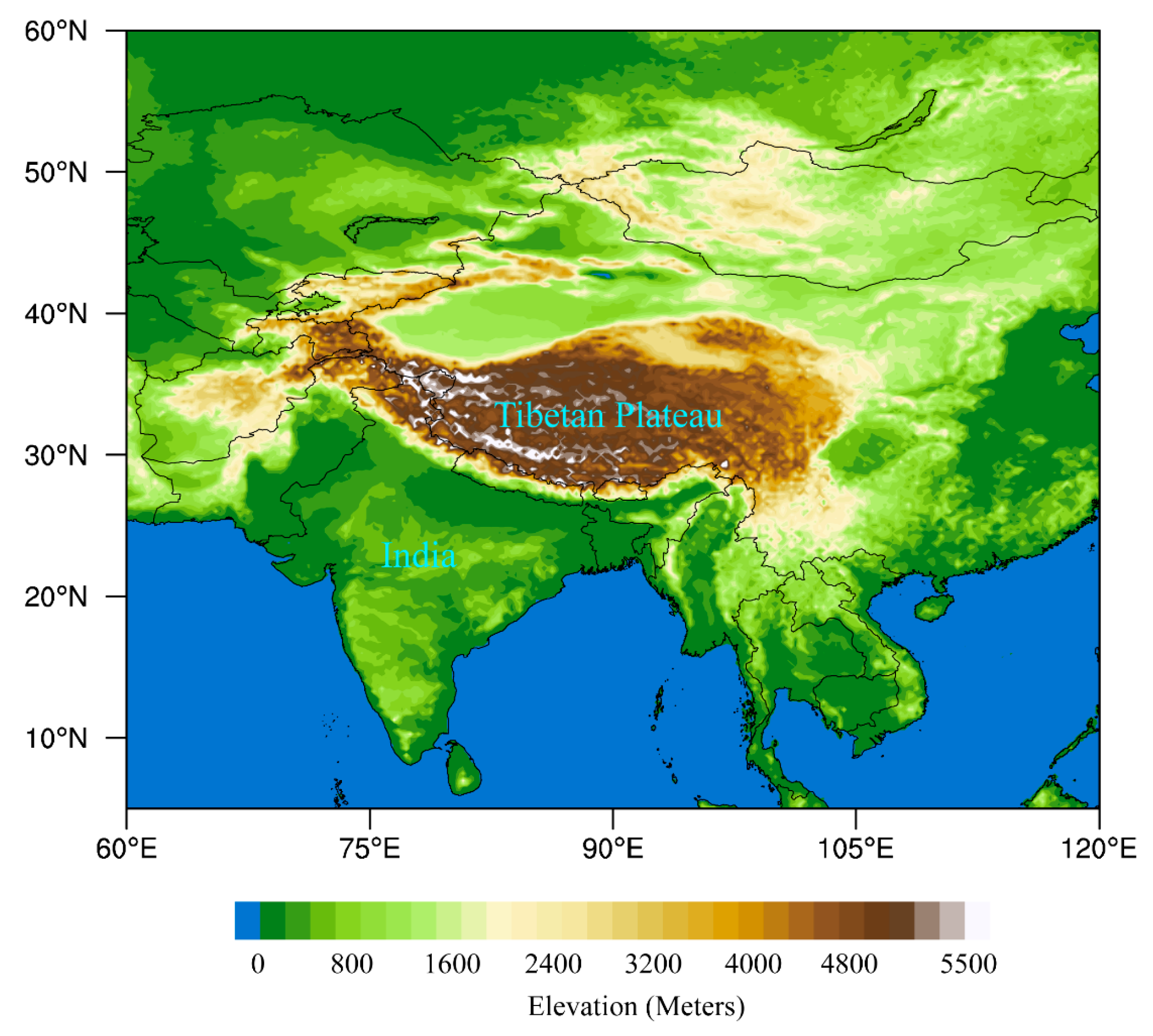
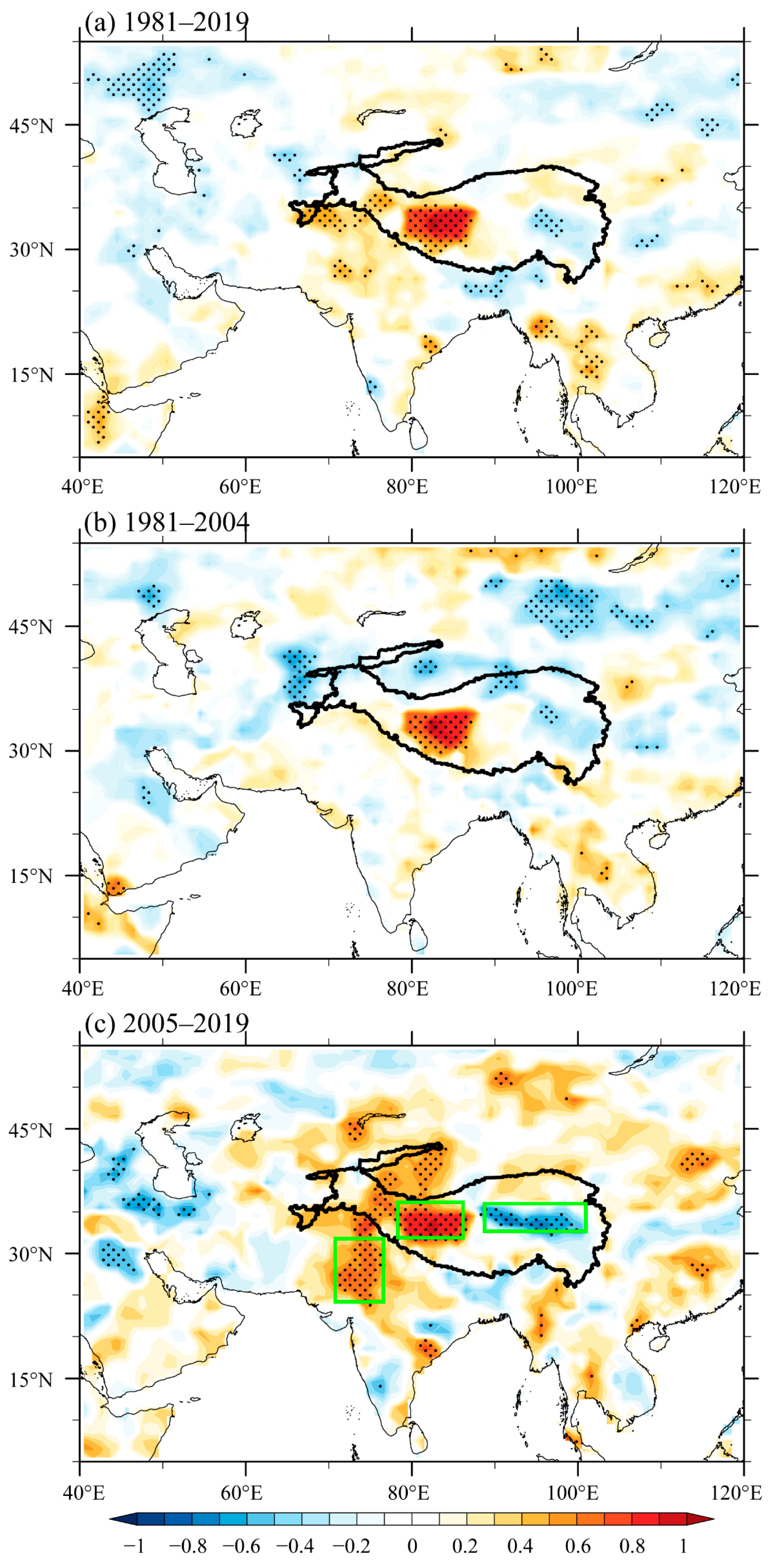
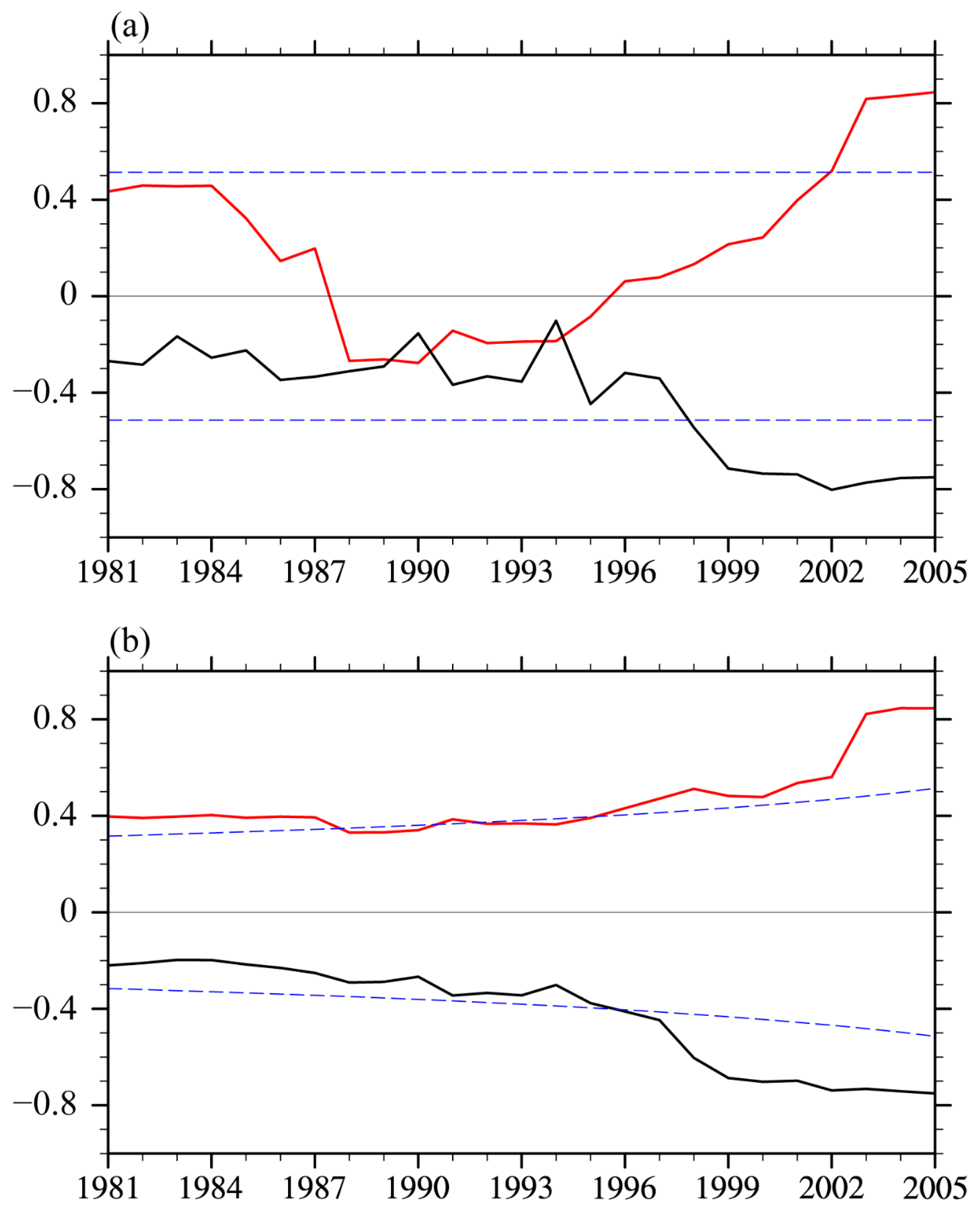
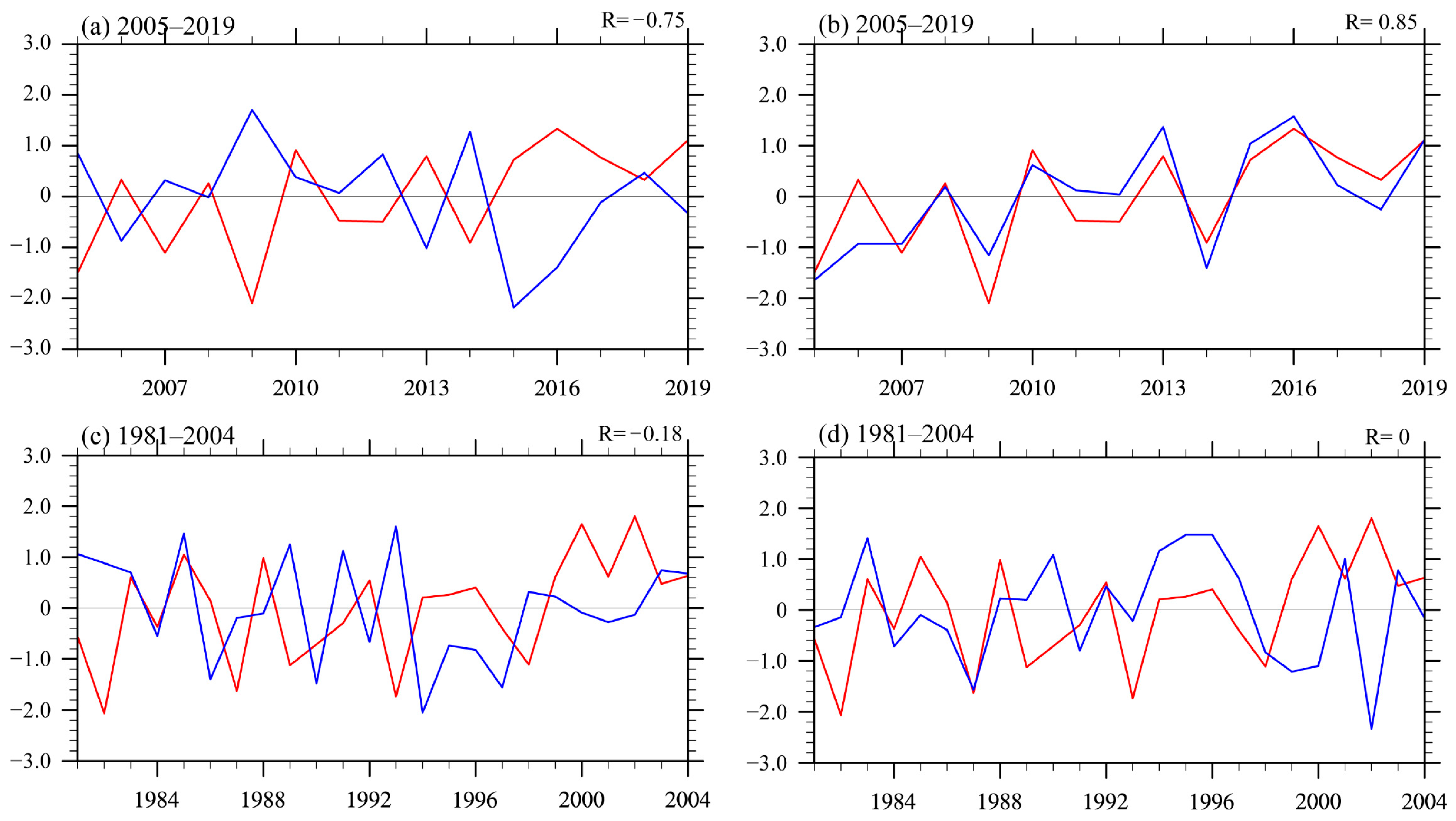
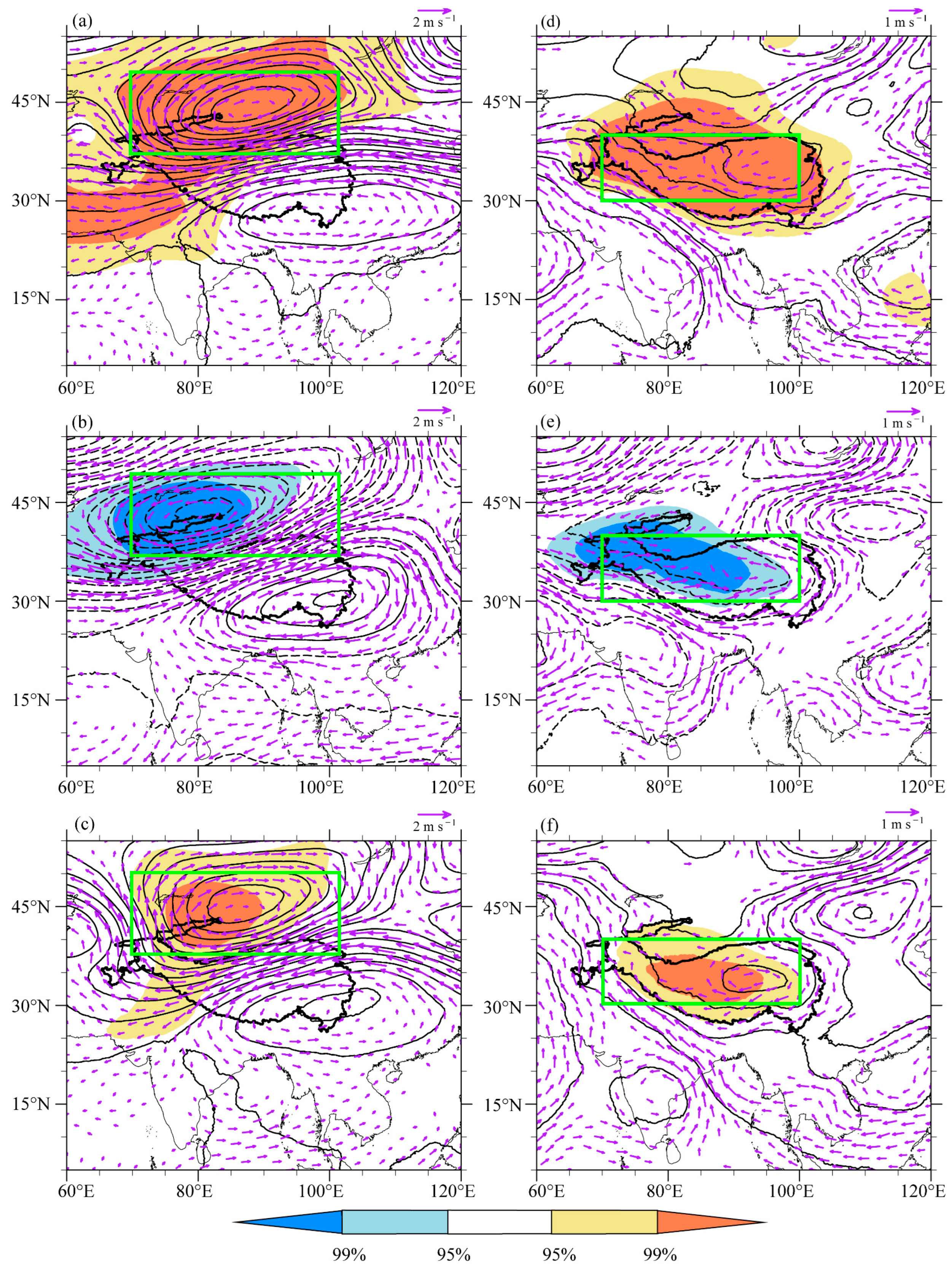
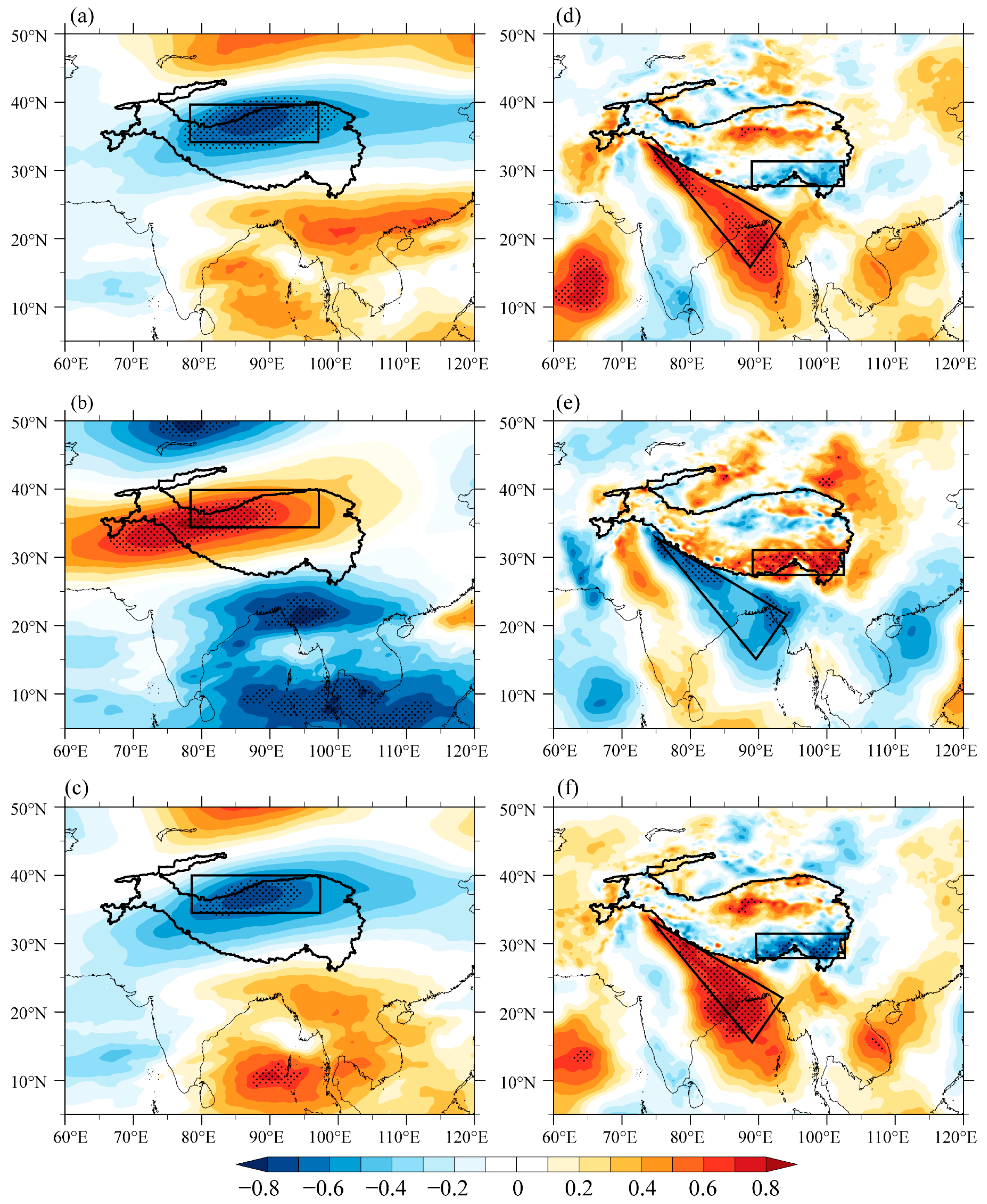
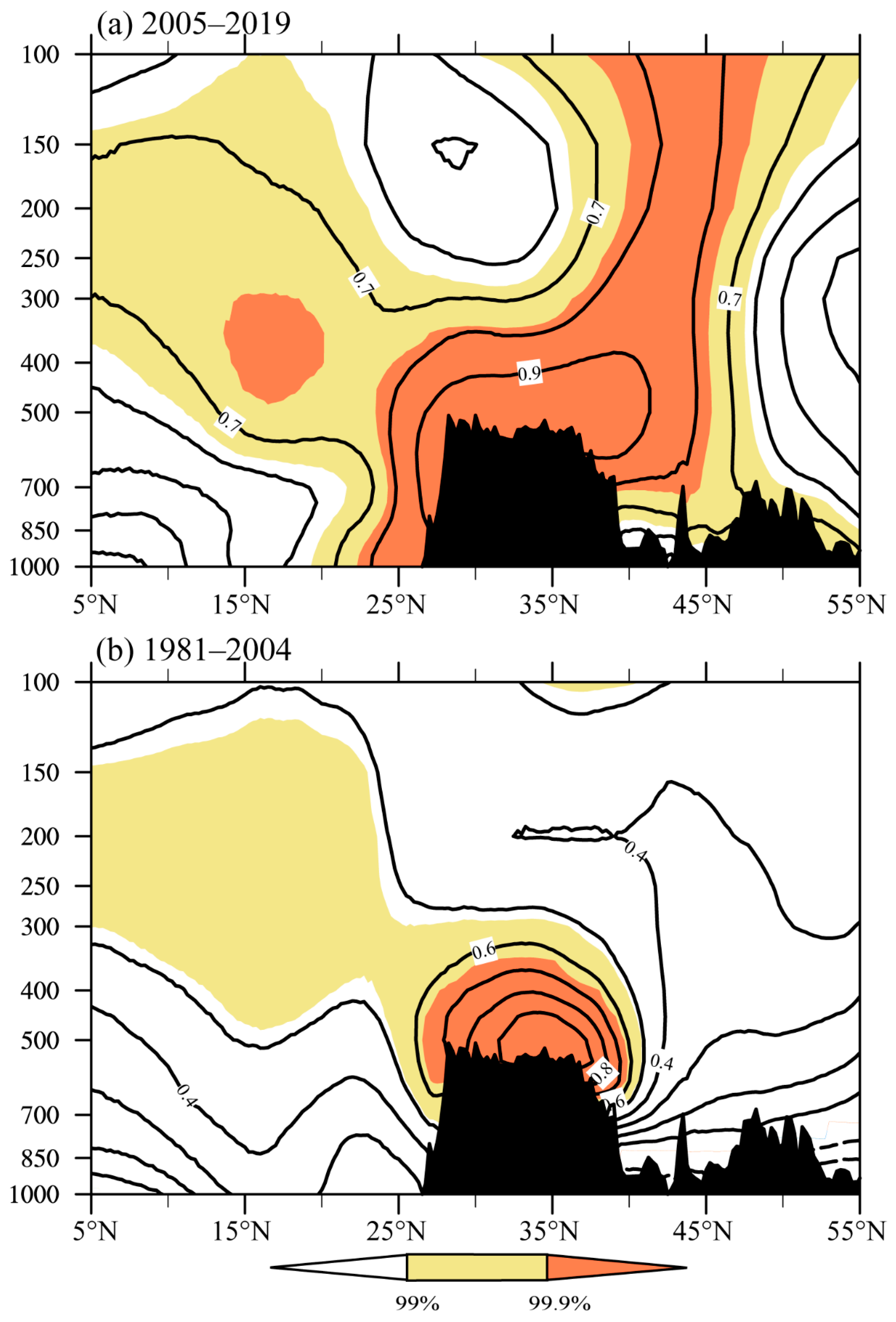
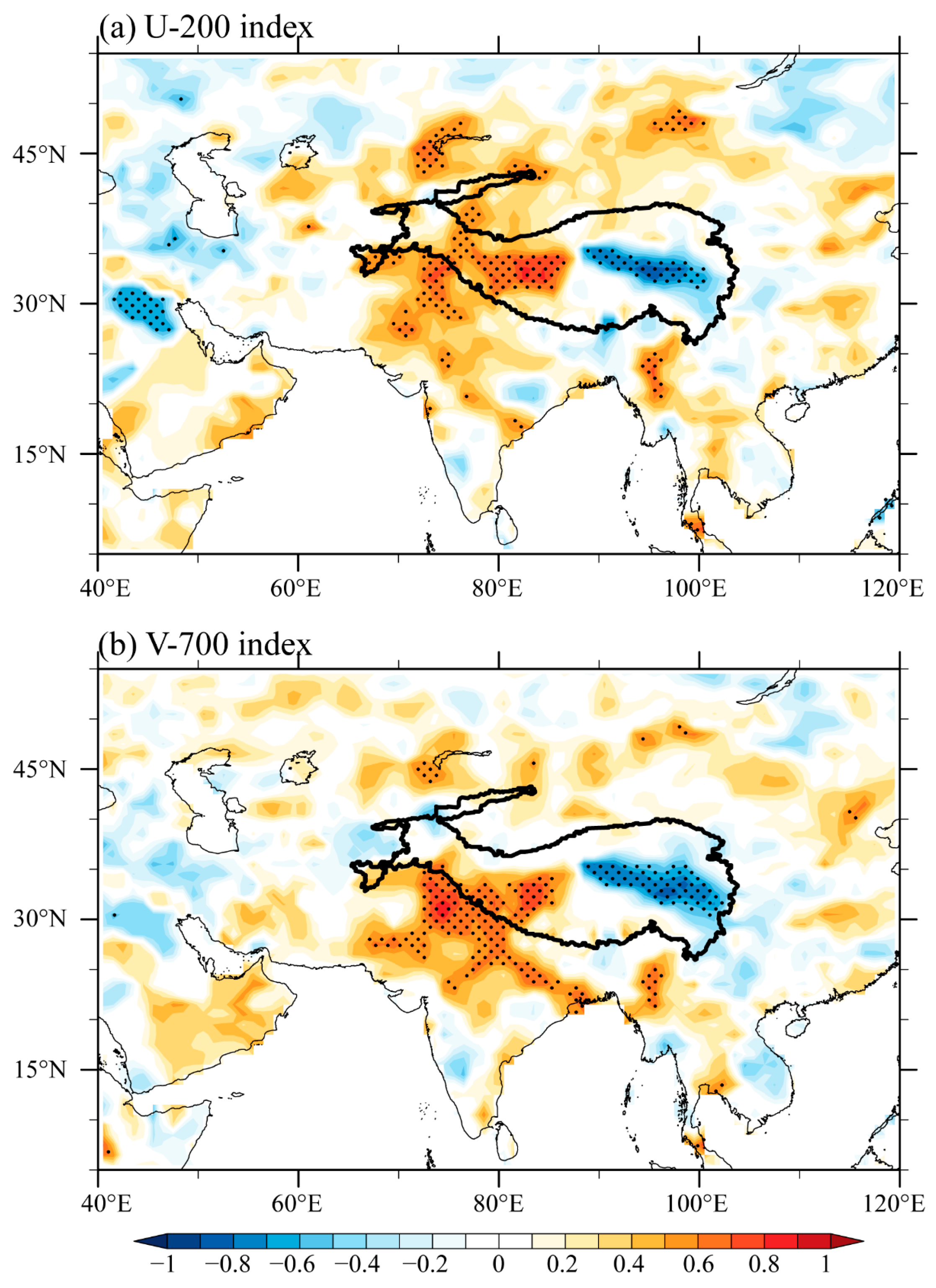
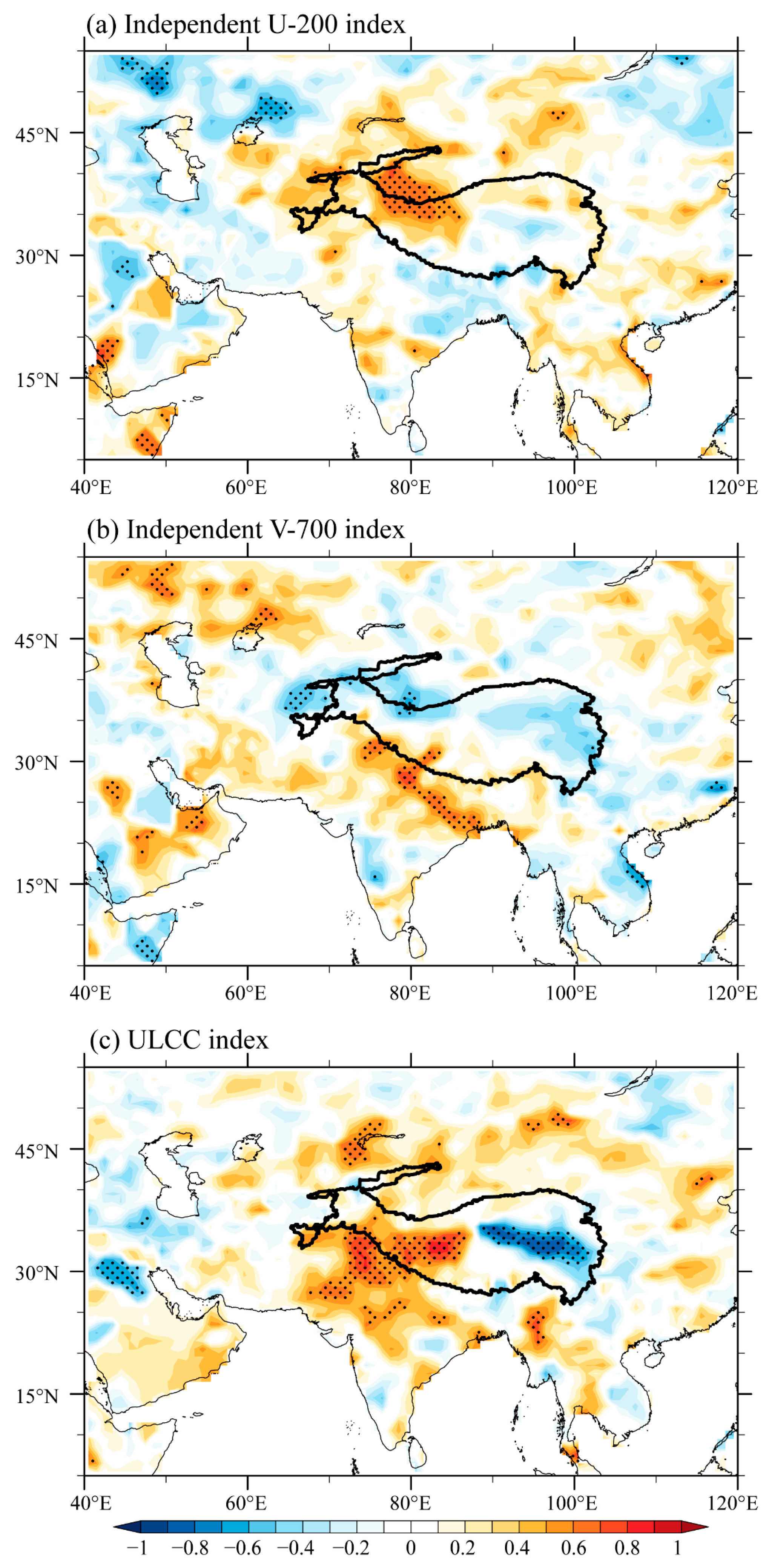

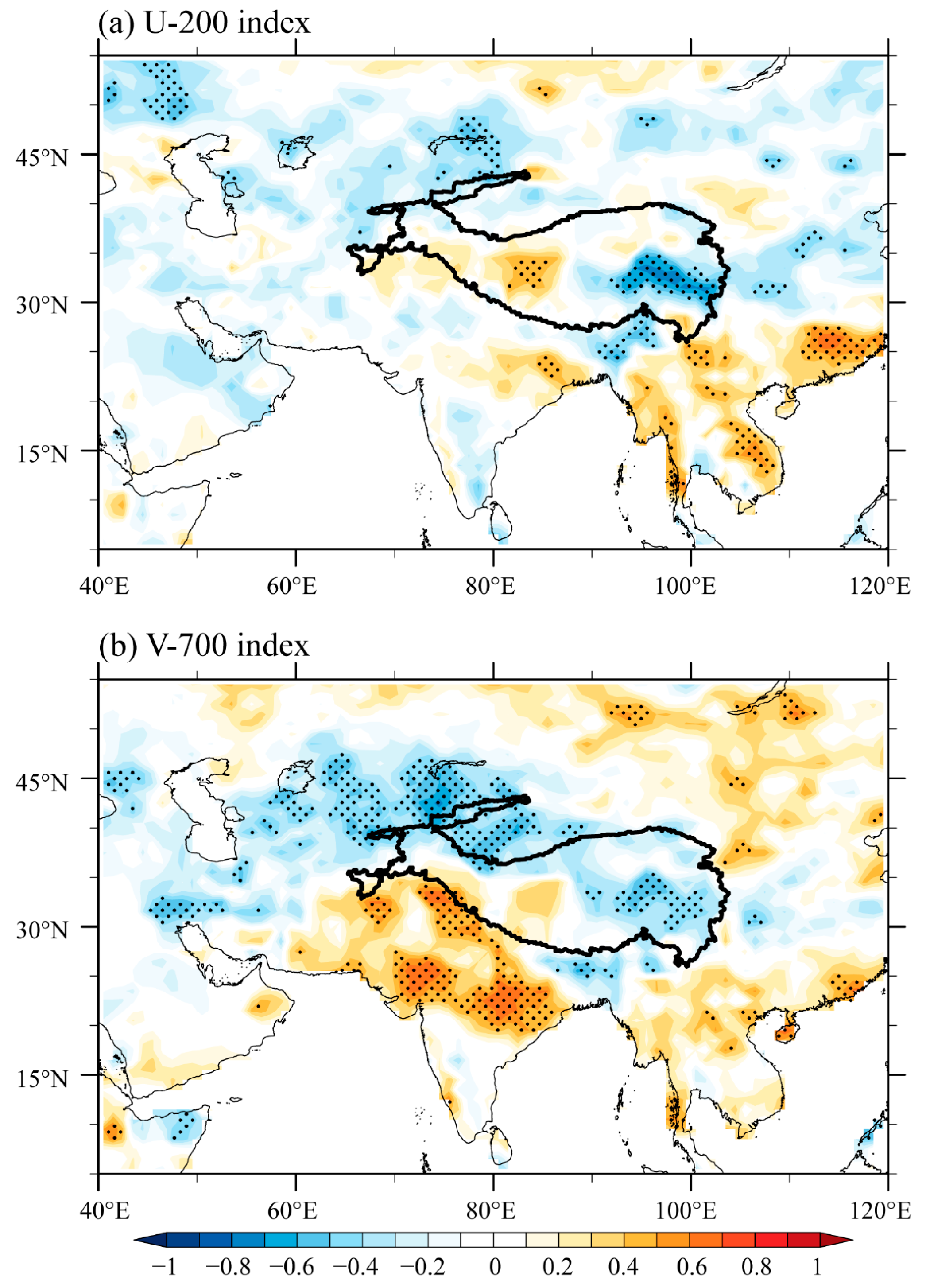
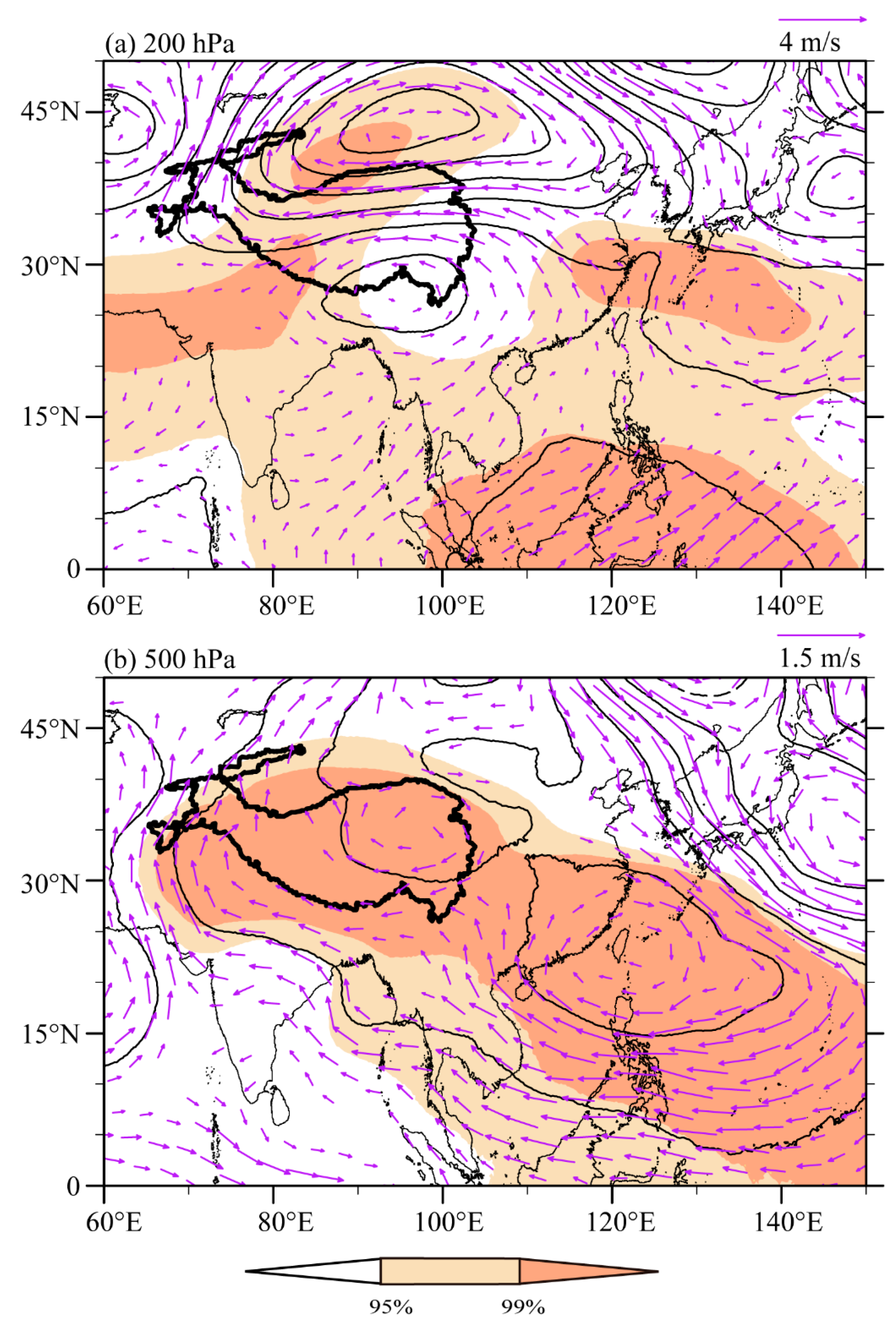


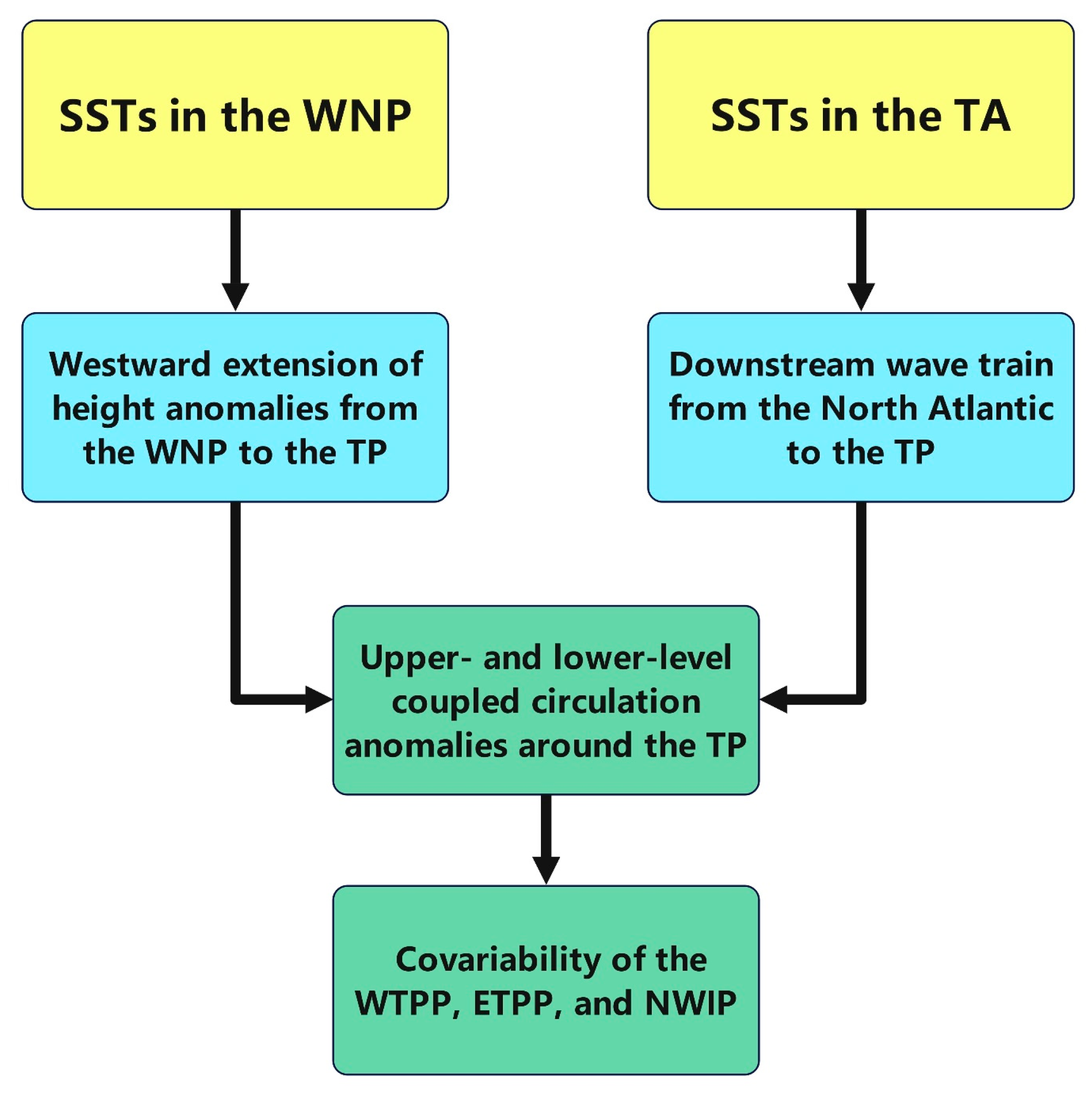
Disclaimer/Publisher’s Note: The statements, opinions and data contained in all publications are solely those of the individual author(s) and contributor(s) and not of MDPI and/or the editor(s). MDPI and/or the editor(s) disclaim responsibility for any injury to people or property resulting from any ideas, methods, instructions or products referred to in the content. |
© 2024 by the authors. Licensee MDPI, Basel, Switzerland. This article is an open access article distributed under the terms and conditions of the Creative Commons Attribution (CC BY) license (https://creativecommons.org/licenses/by/4.0/).
Share and Cite
Wei, X.; Liu, G.; Nan, S.; Qian, T.; Zhang, T.; Mao, X.; Feng, Y.; Zhou, Y. Interdecadal Change in the Covariability of the Tibetan Plateau and Indian Summer Precipitation and Associated Circulation Anomalies. Atmosphere 2024, 15, 117. https://doi.org/10.3390/atmos15010117
Wei X, Liu G, Nan S, Qian T, Zhang T, Mao X, Feng Y, Zhou Y. Interdecadal Change in the Covariability of the Tibetan Plateau and Indian Summer Precipitation and Associated Circulation Anomalies. Atmosphere. 2024; 15(1):117. https://doi.org/10.3390/atmos15010117
Chicago/Turabian StyleWei, Xinchen, Ge Liu, Sulan Nan, Tingting Qian, Ting Zhang, Xin Mao, Yuhan Feng, and Yuwei Zhou. 2024. "Interdecadal Change in the Covariability of the Tibetan Plateau and Indian Summer Precipitation and Associated Circulation Anomalies" Atmosphere 15, no. 1: 117. https://doi.org/10.3390/atmos15010117
APA StyleWei, X., Liu, G., Nan, S., Qian, T., Zhang, T., Mao, X., Feng, Y., & Zhou, Y. (2024). Interdecadal Change in the Covariability of the Tibetan Plateau and Indian Summer Precipitation and Associated Circulation Anomalies. Atmosphere, 15(1), 117. https://doi.org/10.3390/atmos15010117




